
| 
|  |
|
|
This page contains present day photos (Year 2000 to date) of Ontario's King's Highway 17, arranged by location from White River
northerly to Marathon. All photographs displayed on this page were taken by the Webmaster (Cameron Bevers), unless specifically noted otherwise. Click on any
thumbnail to see a larger image!
Please note that all photographs displayed on this
website are protected by copyright. These photographs must not be reproduced, published,
electronically stored or copied, distributed, or posted onto other websites without
my written permission. If you want to use photos from this website, please
email me first for permission. Thank-you!
|
|---|
|
Page 24: Present Day King's Highway 17 Photographs (White River to Marathon)
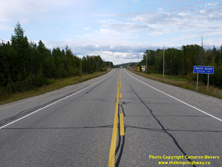
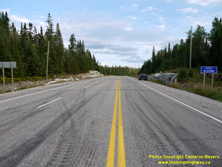
Left - Blue-and-white municipality sign approaching White River on southbound Hwy 17. Although White River is actually an incorporated municipal township, I
make reference to the "Town of White River" to identify distances of various features along Hwy 17 measured from the fringe of the urban area. I have also done this
to differentiate the urbanized area of the township from the river of the same name, which crosses Hwy 17 twice throughout this area. See an
Enlarged Photo Here. (Photograph taken on September 3, 2011 - © Cameron Bevers) Right - District of Algoma boundary sign on southbound Hwy 17. The boundary line between the District of Algoma and the District of Thunder Bay crosses Hwy 17 about 5 km north of the Town of White River. See an Enlarged Photo Here. (Photograph taken on September 3, 2011 - © Cameron Bevers) 

Left - Blue-and-white District of Thunder Bay boundary sign on northbound Hwy 17. The Department of Highways of Ontario (DHO) accelerated construction work on
Hwy 17 during the mid-1950s in order to complete the Trans-Canada Highway through "The Gap" - a road-less wilderness around the remote northern and eastern sides of
Lake Superior. Rather than have construction work on Hwy 17 advance only from either end, construction began on an isolated middle section of Hwy 17 in 1954. This
highway section extended both north and south of the Town of White River. Contracts were awarded in the Summer of 1954 for about 50 miles of right-of-way clearing,
with all equipment and crews transported into White River via railway or by air. By the end of 1957, Hwy 17 was completed for a distance of 20 miles in the vicinity
of the Town of White River, even though the highway had no external access or outlet. The discontinuous White River section of Hwy 17 was eventually linked to the
Marathon leg of Hwy 17 in 1958 and to the Wawa leg of Hwy 17 in 1960. See an
Enlarged Photo Here. (Photograph taken on September 3, 2011 - © Cameron Bevers) Right - Facing north along Hwy 17 towards Marathon at the White River Bridge (Site #48E-33) near Bremner, located about 17 km northwest of the Town of White River. See an Enlarged Photo Here. (Photograph taken on August 29, 2011 - © Cameron Bevers) 

Left - Eastern side of the White River Bridge on Hwy 17 northwest of the Town of White River. This three-span steel plate girder structure was built under
Contracts #1957-43 (structural steel) and #1957-187 (concrete substructure and approaches) and was completed and opened to traffic in November 1958. This bridge
briefly marked the northern terminus of the White River section of Hwy 17, which was built in advance of other sections of the Trans-Canada Highway during the
mid-1950s. The completion of temporary bridges over the White River, West White River and Bertrand Creek allowed the discontinuous White River section of Hwy 17 to be
united with the completed section of Hwy 17 lying southeast of Marathon in 1958. Permanent bridges along the highway between the Town of White River and Marathon were
completed gradually between 1958 and 1961. See an Enlarged Photo Here. (Photograph taken on August 29, 2011 - © Cameron Bevers) Right - Facing south along Hwy 17 towards the Town of White River at the White River Bridge. See an Enlarged Photo Here. (Photograph taken on August 29, 2011 - © Cameron Bevers) 

Left - Western side of the White River Bridge, located about 17 km northwest of the Town of White River. See an
Enlarged Photo Here. (Photograph taken on August 29, 2011 - © Cameron Bevers) Right - Facing south along Hwy 17 from the West White River Bridge, located about 21 km northwest of the Town of White River. Although the forest has recovered and regrown significantly in recent years, a major forest fire swept through the area in the late 1990s which destroyed many of the surrounding forests. See an Enlarged Photo Here. (Photograph taken on August 29, 2011 - © Cameron Bevers) 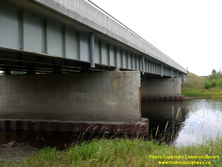
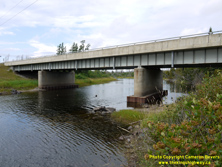
Left - Eastern side of the West White River Bridge (Site #48E-32) on Hwy 17 northwest of the Town of White River. This three-span steel plate girder structure
was built under Contracts #1957-282 (structural steel) and #1958-37 (concrete substructure and approaches) and was completed and opened to traffic in August 1959. A
Bailey Bridge was used temporarily for this crossing while the new permanent bridge was being constructed. See an
Enlarged Photo Here. (Photograph taken on August 29, 2011 - © Cameron Bevers) Right - Western side of the West White River Bridge, located about 21 km northwest of the Town of White River. See an Enlarged Photo Here. (Photograph taken on August 29, 2011 - © Cameron Bevers) 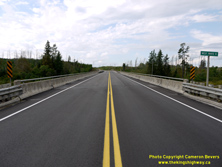

Left - Facing north along Hwy 17 towards Marathon at the West White River Bridge. See an
Enlarged Photo Here. (Photograph taken on August 29, 2011 - © Cameron Bevers) Right - Facing south along Hwy 17 towards the Town of White River at the West White River Bridge. See an Enlarged Photo Here. (Photograph taken on August 29, 2011 - © Cameron Bevers) 
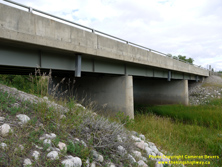
Left - Facing north along Hwy 17 towards Marathon at the Bertrand Creek Bridge, located about 26 km northwest of the Town of White River. See an
Enlarged Photo Here. (Photograph taken on August 29, 2011 - © Cameron Bevers) Right - Western side of the Bertrand Creek Bridge (Site #48E-31). This three-span steel plate girder structure was built under Contracts #1957-297 (structural steel) and #1958-36 (concrete substructure and approaches) and was completed and opened to traffic in June 1959. See an Enlarged Photo Here. (Photograph taken on August 29, 2011 - © Cameron Bevers) 

Left - Facing south along Hwy 17 towards the Town of White River at the Bertrand Creek Bridge. See an
Enlarged Photo Here. (Photograph taken on August 29, 2011 - © Cameron Bevers) Right - Eastern side of the Bertrand Creek Bridge on Hwy 17 northwest of the Town of White River. See an Enlarged Photo Here. (Photograph taken on August 29, 2011 - © Cameron Bevers) 
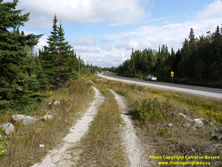
Left - Start of the White Lake Narrows Diversion on Hwy 17 facing north, located about 30 km northwest of the Town of White River. At this point, a 2 km
diversion begins which carries the present day route of Hwy 17 across the White Lake Narrows Bridge. Originally, Hwy 17 curved to the right and headed towards the
White Lake Ferry Dock. Until 1960, there was a physical gap in Hwy 17 at White Lake. A temporary ferry service was provided to carry Hwy 17 traffic until the highway
was finished. See an Enlarged Photo Here. (Photograph taken on August 29, 2011 - © Cameron Bevers) Right - Although Old Hwy 17 is now just a rough trail, observers will note that it is tangential to Hwy 17 departing from this highway curve - a characteristic which is typically indicative of an old highway alignment. About 2 km of Hwy 17 was reconstructed on a new highway alignment in the late 1950s in order to reach the new White Lake Narrows Bridge. See an Enlarged Photo Here. (Photograph taken on August 29, 2011 - © Cameron Bevers) 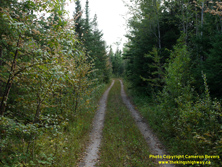

Left - Old Hwy 17 winds its way through the forests as it approaches the eastern White Lake Ferry Dock. Prior to the completion of the Hwy 17 bridge across
White Lake Narrows, the Department of Highways of Ontario (DHO) operated a free ferry service across White Lake for Hwy 17 traffic. Through traffic on Hwy 17 hasn't
used this old route since ferry service across White Lake ceased in 1960. Today, Old Hwy 17 is just a dirt trail, used only by the occasional angler hoping to snag a
prized fish from the depths of White Lake. See an Enlarged Photo Here. (Photograph taken on August 29, 2011 - © Cameron Bevers) Right - Stone and timber ruins of the old DHO Ferry Dock on the eastern side of White Lake. The DHO operated a free ferry service for Hwy 17 traffic across White Lake between 1958 and 1960. At one time, this ferry was the only way to reach the Town of White River by road. See an Enlarged Photo Here. (Photograph taken on August 29, 2011 - © Cameron Bevers) 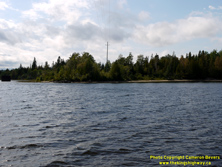

Left - The western DHO Ferry Dock can be seen across White Lake Narrows. Little trace remains today of the western ferry dock, although it was located beside
the aerial hydro pole crossing. The ferry service operated for nearly three years. In this
Historical 1959 Photo, the DHO's White Lake Ferry can be seen in operation beside the new White
Lake Narrows Bridge which was still under construction at the time. Ferry service was discontinued once this new bridge was completed and opened to traffic in 1960.
See an Enlarged Photo Here. (Photograph taken on August 29, 2011 - © Cameron Bevers) Right - Northern approach to the White Lake Narrows Bridge (Site #48E-30) on Hwy 17 north of White River. This beautiful steel arch structure was built under Contracts #1957-114 (structural steel) and #1958-215 (concrete substructure and approaches) and was completed in 1960. See an Enlarged Photo Here. (Photograph taken on August 30, 2003 - © Cameron Bevers) 

Left - Facing north along Hwy 17 towards Marathon approaching the White Lake Narrows Bridge. See an
Enlarged Photo Here. (Photograph taken on August 30, 2003 - © Cameron Bevers) Right - The White Lake Narrows Bridge is a very unusual design, known as a Stabbogen type arch. This was the first time that a bridge of this design was built in Canada. It features a lightweight overhead steel arch which stiffens and reinforces a deep steel plate girder deck through tensioned vertical rods. The result is this impressive steel bowstring arch bridge, which is arguably one of Ontario's most beautiful bridges. Examples of the Stabbogen design are fairly common in Europe, particularly in Germany. The design never saw widespread use in North America, and consequently, bridges of this type are very rare here. See an Enlarged Photo Here. (Photograph taken on August 29, 2006 - © Cameron Bevers) 

Left - Bridge manufacturer's plaque on the White Lake Narrows Bridge on Hwy 17 northwest of the Town of White River. The main Stabbogen truss span was
manufactured by the Canadian Bridge Division of the Dominion Steel & Coal Corporation. The White Lake Narrows Bridge was completed in 1960 and was rehabilitated
in 1993 and once again in 2018. See an Enlarged Photo Here. (Photograph taken on August 30, 2003 - © Cameron Bevers) Right - Facing south along Hwy 17 towards the Town of White River at the White Lake Narrows Bridge. See an Enlarged Photo Here. (Photograph taken on August 29, 2006 - © Cameron Bevers) 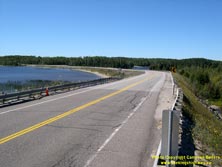
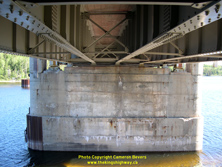
Left - Facing north along Hwy 17 towards Marathon from the White Lake Narrows Bridge. A rock causeway was built across White Lake during the bridge's
construction. The causeway is about 500 metres in length. not including the structure itself. See an
Enlarged Photo Here. (Photograph taken on August 29, 2006 - © Cameron Bevers) Right - Steel plate girder superstructure of the White Lake Narrows Bridge on Hwy 17. See an Enlarged Photo Here. (Photograph taken on August 29, 2006 - © Cameron Bevers) 
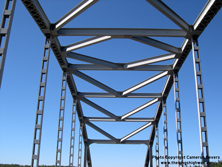
Left - White Lake Narrows Bridge on Hwy 17 between White River and Marathon. This remarkable bridge is truly an engineering masterpiece, providing a perfect
balance between beauty and function. It is one of the finest bridges ever constructed in the Province of Ontario. See an
Enlarged Photo Here. (Photograph taken on August 29, 2006 - © Cameron Bevers) Right - Overhead steel arch of the White Lake Narrows Bridge on Hwy 17. The White Lake Narrows Bridge is one of only three overhead steel arch bridges ever built on a King's Highway. The two other examples include the arched centre span of the Burlington Skyway on the Queen Elizabeth Way and the Montreal River Bridge located on Hwy 11 in Latchford. See an Enlarged Photo Here. (Photograph taken on August 29, 2006 - © Cameron Bevers) 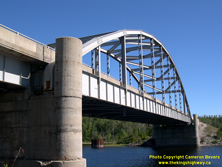
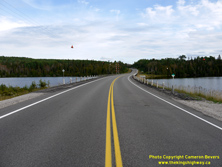
Left - The 275-foot overhead steel arch of the White Lake Narrows Bridge is supported on two concrete piers in the channel. The arch is affixed to
a heavy-duty steel plate girder main span. The two approach spans are 90 feet in length and are simply supported steel plate girder structures. The total
length of the White Lake Narrows Bridge is 455 feet (139 metres). The rest of the White Lake crossing was achieved through the construction of a long
causeway. See an Enlarged Photo Here. (Photograph taken on August 29, 2006 - © Cameron Bevers) Right - Causeway carrying Hwy 17 across Dunc Lake, facing south towards White Lake Provincial Park. See an Enlarged Photo Here. (Photograph taken on September 3, 2011 - © Cameron Bevers) 

Left - Facing north along Hwy 17 towards Marathon at Dunc Lake, located about 13 km south of the Hwy 614 Junction. See an
Enlarged Photo Here. (Photograph taken on September 3, 2011 - © Cameron Bevers) Right - Facing south along Hwy 17 towards the Town of White River from the Wabikoba Creek Bridge, located 5 km southeast of the Hwy 614 Junction at Hemlo. As was the typical practise at the time of this older steel beam guide rail system's installation, the ends of the guide rails were buried below grade into the shoulder. This is an installation technique which is obsolete and is no longer used today. Examples of this type of installation have become a very uncommon sight along Ontario's highways in more recent years. They are being actively removed and replaced with energy attenuating terminals during various highway reconstruction projects. See an Enlarged Photo Here. (Photograph taken on August 29, 2011 - © Cameron Bevers) 

Left - Facing north along Hwy 17 towards Marathon at the Wabikoba Creek Bridge near the Hwy 614 Junction at Hemlo. See an
Enlarged Photo Here. (Photograph taken on August 29, 2011 - © Cameron Bevers) Right - Western side of the Wabikoba Creek Bridge on Hwy 17. This three-span steel beam bridge was constructed under Contracts #1957-300 (structural steel) and #1958-43 (concrete substructure and approaches) and was completed and opened to traffic in August 1959. See an Enlarged Photo Here. (Photograph taken on August 29, 2011 - © Cameron Bevers) 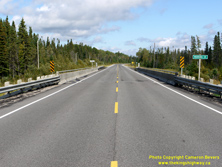
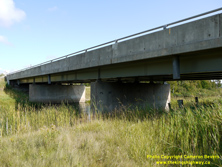
Left - Facing south along Hwy 17 towards the Town of White River at the Wabikoba Creek Bridge. See an
Enlarged Photo Here. (Photograph taken on August 29, 2011 - © Cameron Bevers) Right - Eastern side of the Wabikoba Creek Bridge (Site #48E-29) on Hwy 17 southeast of Hemlo. See an Enlarged Photo Here. (Photograph taken on August 29, 2011 - © Cameron Bevers) 

Left - Facing south along Hwy 17 at the Manitouwadge Canadian Pacific Railway (CPR) Overhead, located immediately south of the Hwy 614 Junction at Hemlo. See
an Enlarged Photo Here. (Photograph taken on August 29, 2011 - © Cameron Bevers) Right - Southern side of the Manitouwadge CPR Overhead (Site #48E-28) on Hwy 17. This single-span concrete slab structure was built under Contract #1957-248 and was completed and opened to traffic in November 1958. The railway spur to Manitouwadge was subsequently abandoned. Accordingly, this disused railway overhead was demolished and removed from underneath the highway several years ago. See an Enlarged Photo Here. (Photograph taken on August 29, 2011 - © Cameron Bevers) 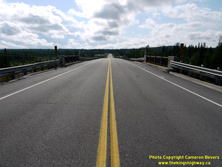
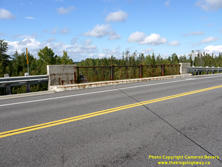
Left - Facing north along Hwy 17 towards the Hwy 614 Junction at the Manitouwadge CPR Overhead. See an
Enlarged Photo Here. (Photograph taken on August 29, 2011 - © Cameron Bevers) Right - Close-up of the concrete and steel handrail design of the Manitouwadge CPR Overhead at Hemlo. See an Enlarged Photo Here. (Photograph taken on August 29, 2011 - © Cameron Bevers) 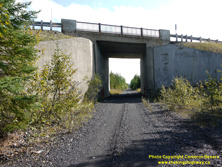

Left - Northern side of the Manitouwadge CPR Overhead on Hwy 17 at the Hwy 614 Junction. See an
Enlarged Photo Here. (Photograph taken on August 29, 2011 - © Cameron Bevers) Right - Facing west (north) along Hwy 17 approaching the Hwy 614 Junction at Hemlo. These two highways intersect about 50 km northeast of the Town of White River. Hwy 614 serves as the main highway access leading into Manitouwadge, which is located about 50 km north of Hwy 17. See an Enlarged Photo Here. (Photograph taken on August 29, 2011 - © Cameron Bevers) 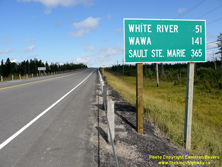
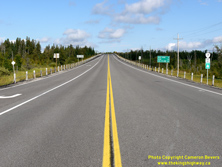
Left - Distance guide sign facing eastbound (southbound) traffic on Hwy 17 at the Hwy 614 Junction. This highway junction is approximately the mid-way point
between Sault Ste. Marie and Thunder Bay. It is also the point where Hwy 17 begins to be signed as an east-west route again, rather than as a north-south route. See
an Enlarged Photo Here. (Photograph taken on August 29, 2011 - © Cameron Bevers) Right - Facing east (south) along Hwy 17 towards the Town of White River from the Hwy 614 Junction at Hemlo. See an Enlarged Photo Here. (Photograph taken on August 29, 2011 - © Cameron Bevers) 

Left - Junction sign assembly facing eastbound (southbound) traffic on Hwy 17 at the Hwy 614 Junction. See
an Enlarged Photo Here. (Photograph taken on August 29, 2011 - © Cameron Bevers) Right - Facing east (south) along Hwy 17 approaching the turn-off to Manitouwadge at the Hwy 614 Junction. See an Enlarged Photo Here. (Photograph taken on August 29, 2011 - © Cameron Bevers) 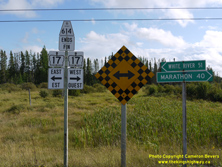

Left - Junction sign assembly and fingerboard guide signs at the Hwy 614 and Hwy 17 Junction at Hemlo. Until recent years, Hwy 17 was signed with "North" and
"South" cardinal directions between this highway junction and Nipigon. The cardinal directions along Hwy 17 between the Hwy 614 Junction and Nipigon were apparently
in the process of being changed to "East" and "West" when I was visiting Northwestern Ontario in 2011. See an
Enlarged Photo Here. (Photograph taken on August 29, 2011 - © Cameron Bevers) Right - Facing north along Hwy 614 towards Manitouwadge from the Hwy 17 Junction near Hemlo. The route of Hwy 614 from Hemlo to Manitouwadge was first designated as a Secondary Highway in May 1956. However, it wasn't until late 1956 that Hwy 614 was actually linked to the rest of Ontario's Highway System. As construction progressed on the Trans-Canada Highway east of Marathon, traffic was eventually permitted to use the newly-constructed section of Hwy 17 as far east as Hemlo. Road access from Marathon to Manitouwadge was therefore possible once the new section of Hwy 17 was opened to traffic between Marathon and Hemlo. See an Enlarged Photo Here. (Photograph taken on August 29, 2011 - © Cameron Bevers) 
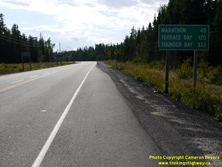
Left - Southern terminus of Hwy 614 at the Hwy 17 Junction at Hemlo, located southeast of Marathon. See an
Enlarged Photo Here. (Photograph taken on August 29, 2011 - © Cameron Bevers) Right - Distance guide sign facing westbound (northbound) traffic on Hwy 17 at the Hwy 614 Junction. See an Enlarged Photo Here. (Photograph taken on August 29, 2011 - © Cameron Bevers) 
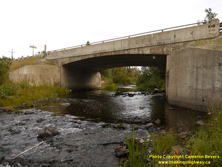
Left - Facing west along Hwy 17 towards Marathon from Yellow Brick Road at Hemlo. The Hemlo
mining area has proven to be one of Ontario's most lucrative mining operations over the past several decades. Large gold mines are clustered along Hwy 17 about 2 km
west of the Hwy 614 Junction. These gold mines provide an interesting industrial interruption from the never-ending forests which line Hwy 17 in this area. The Hemlo
Mine operated by Barrick Gold has yielded an astonishing 21 million ounces of gold since the mine began operation in the 1980s. The total gold value extracted from
the mine carries a 2023 value in excess of $55 Billion Canadian Dollars. With so much gold found in this area in recent decades, one can't help but wonder if the DHO
could have struck gold itself, had only its engineers selected an alignment for Hwy 17 just a bit further to the north or south of where it was actually built? See an
Enlarged Photo Here. (Photograph taken on September 3, 2011 - © Cameron Bevers) Right - Northern side of the Cedar Creek Bridge (Site #48E-27) on Hwy 17, located about 53 km northwest of the Town of White River. This single-span concrete rigid frame structure was built under Contract #1957-174 and was completed in 1958. See an Enlarged Photo Here. (Photograph taken on September 3, 2011 - © Cameron Bevers) 
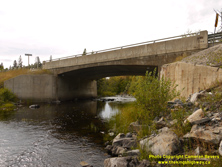
Left - Facing west along Hwy 17 towards Marathon at the Cedar Creek Bridge at Hemlo. See an
Enlarged Photo Here. (Photograph taken on September 3, 2011 - © Cameron Bevers) Right - Southern side of the Cedar Creek Bridge on Hwy 17. This seemingly peaceful northern scene in this photo is rather deceiving, as it lies right in the centre of the Hemlo gold field's mining operations. One doesn't have to travel far along Hwy 17 to be back in the wilderness again. The Hemlo mining district is concentrated into a very small geographic area. See an Enlarged Photo Here. (Photograph taken on September 3, 2011 - © Cameron Bevers) 

Left - Facing east along Hwy 17 at the Cedar Creek Bridge. This structure lies just west of Yellow Brick Road and about 2 km west of the Hwy 614 Junction. See
an Enlarged Photo Here. (Photograph taken on September 3, 2011 - © Cameron Bevers) Right - Green guide sign for Yellow Brick Road on eastbound Hwy 17. This seems like a perfectly suitable name for an access road to a gold mine - indeed, there have been many yellow bricks produced by these mines over the years! See an Enlarged Photo Here. (Photograph taken on September 3, 2011 - © Cameron Bevers) 
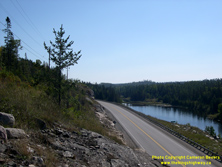
Left - Facing west along Hwy 17 towards Marathon at Cigar Lake, located about 7 km west of the Hwy 614 Junction. This scenic section of Hwy 17 is one of the
highlights along the drive to Marathon from the Hwy 614 Junction at Hemlo. See an
Enlarged Photo Here. (Photograph taken on September 5, 2006 - © Cameron Bevers) Right - Hwy 17 at Cigar Lake east of Marathon, facing east towards the Hwy 614 Junction. The section of Hwy 17 from just east of Marathon easterly towards White Lake was constructed and graded under Contracts #1955-49 (Mile 0 to Mile 10), #1956-43 (Mile 10 to Mile 22) and #1956-78 (Mile 22 to Mile 34). Hot-mix paving was completed from the Pic River Bridge easterly to White Lake Narrows under two paving contracts (Contracts #1958-124 and #1958-178) which were both completed in 1959. See an Enlarged Photo Here. (Photograph taken on September 5, 2006 - © Cameron Bevers) 

Left - Approaching the Black River Bridge on Hwy 17, facing west towards Marathon. This structure is located about 6 km east of the Hwy 627 Junction. See an
Enlarged Photo Here. (Photograph taken on September 5, 2006 - © Cameron Bevers) Right - Northern side of the Black River Bridge (Site #48E-26) on Hwy 17, located east of Marathon. This three-span steel girder structure was built under Contracts #1956-154 (structural steel) and #1957-83 (concrete substructure and approaches) and was completed in 1958. It was replaced with a new structure in 2012. See an Enlarged Photo Here. (Photograph taken on September 5, 2006 - © Cameron Bevers) 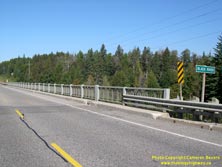
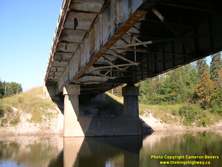
Left - Close-up of the steel handrail design of the Black River Bridge on Hwy 17 east of Marathon. See an
Enlarged Photo Here. (Photograph taken on September 5, 2006 - © Cameron Bevers) Right - The Black River Bridge is a three-span steel plate girder structure. See an Enlarged Photo Here. (Photograph taken on September 5, 2006 - © Cameron Bevers) 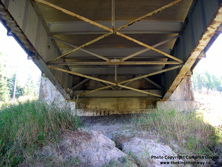
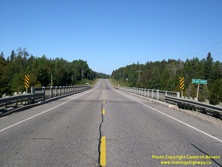
Left - The Black River Bridge has two deep longitudinal steel girders. The two girders support multiple transverse steel deck beams. See an
Enlarged Photo Here. (Photograph taken on September 5, 2006 - © Cameron Bevers) Right - Facing west along Hwy 17 towards Marathon at the Black River Bridge. See an Enlarged Photo Here. (Photograph taken on September 5, 2006 - © Cameron Bevers) 
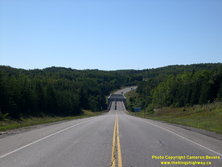
Left - Facing west along Hwy 17 towards Marathon about 1 km east of the Pic River Bridge. The Hwy 627 Junction can also be seen in the far distance, part-way
up the hill beyond the Pic River Bridge. A long eastbound passing lane begins along Hwy 17 just east of the Pic River Bridge, on account of the grade. See an
Enlarged Photo Here. (Photograph taken on August 29, 2006 - © Cameron Bevers) Right - Approaching the Pic River Bridge on Hwy 17, facing west towards Marathon. This interesting steel through truss structure lies just east of the Hwy 627 Junction. See an Enlarged Photo Here. (Photograph taken on August 29, 2006 - © Cameron Bevers) 

Left - Southern side of the Pic River Bridge (Site #48E-25) on Hwy 17. This massive steel through truss structure was completed in 1961. The bridge consists of
a continuous steel through truss superstructure with a total length coming in at a whopping 584 feet (178 metres). See an
Enlarged Photo Here. (Photograph taken on August 29, 2006 - © Cameron Bevers) Right - Facing west across the Pic River Bridge on Hwy 17 towards Marathon. See an Enlarged Photo Here. (Photograph taken on August 29, 2006 - © Cameron Bevers) 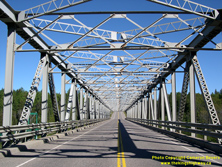
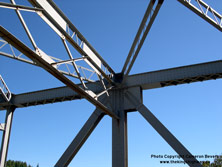
Left - The Pic River Bridge features a unique continuous through truss design across its three spans. All other multiple-span through truss bridges on
Ontario's Highways are comprised of separate individual trusses. The design of this bridge was rather complicated and had to be constructed very carefully over a
period of several years, due to numerous geotechnical engineering challenges at this particular river crossing location. See an
Enlarged Photo Here. (Photograph taken on August 29, 2006 - © Cameron Bevers) Right - Close-up view of the intricate steel truss members of the Pic River Bridge on Hwy 17. See an Enlarged Photo Here. (Photograph taken on August 29, 2006 - © Cameron Bevers) 

Left - Still going! The Pic River Bridge is by far the longest steel through truss bridge on Hwy 17. This steel structure was built under Contracts #1960-146
(structural steel) and #1961-20 (concrete superstructure), with the subsurface pilings and concrete substructure completed under Contract #1958-256. The construction
of this bridge was staged carefully in order to ensure proper settlement before the steel and concrete superstructure was erected. Traffic on Hwy 17 was carried over
a Bailey Bridge until the permanent bridge over the Pic River was completed in the Fall of 1961. See an
Enlarged Photo Here. (Photograph taken on August 29, 2006 - © Cameron Bevers) Right - Facing east along Hwy 17 towards the Town of White River at the Pic River Bridge near Marathon. See an Enlarged Photo Here. (Photograph taken on August 29, 2006 - © Cameron Bevers) 

Left - For several years, a Bailey Bridge carried Hwy 17 traffic across the Pic River a short distance south of the current Hwy 17 bridge's location.
Constructed in 1955 under Contract #1955-49, the Pic River Bailey Bridge had an impressive 180-foot main span supported on rock-filled cribs. The cribs had to be
constructed on piles due to unstable local soil conditions. This Bailey Bridge remained in service until 1961, when a permanent bridge was completed across the Pic
River. Although the steel bridge span was removed, the rotting timber cribs now lie in ruins and are slowly being reclaimed by the surrounding forests. See an
Enlarged Photo Here. (Photograph taken on August 29, 2006 - © Cameron Bevers) Right - Below-deck view of the Pic River Bridge south of Marathon. See an Enlarged Photo Here. (Photograph taken on August 29, 2006 - © Cameron Bevers) 

Left - The Pic River Bridge consists of one continuous Warren Truss assembly supported over two piers, resulting in three spans. See an
Enlarged Photo Here. (Photograph taken on August 29, 2006 - © Cameron Bevers) Right - Close-up of a riveted connection of truss members on the Pic River Bridge. See an Enlarged Photo Here. (Photograph taken on August 29, 2006 - © Cameron Bevers) 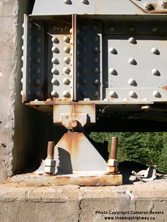

Left - Fixed pin connection on the western Pic River Bridge abutment. See an
Enlarged Photo Here. (Photograph taken on August 29, 2006 - © Cameron Bevers) Right - Roller connection on the eastern Pic River Bridge abutment. The roller connection allows subtle longitudinal movement of the span due to expansion and contraction of the structural steel at various ambient temperatures. See an Enlarged Photo Here. (Photograph taken on August 29, 2006 - © Cameron Bevers) 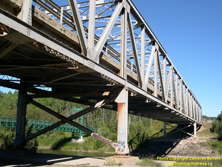

Left - Pier design of the Pic River Bridge near Marathon. The continuous through truss superstructure rests on two steel piers offset from the river banks. See
an Enlarged Photo Here. (Photograph taken on August 29, 2006 - © Cameron Bevers) Right - Close-up of the Pic River Bridge's concrete parapet wall design. See an Enlarged Photo Here. (Photograph taken on August 29, 2006 - © Cameron Bevers) 
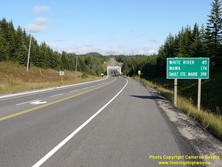
Left - Facing east along Hwy 17 towards the Town of White River approaching the Pic River Bridge east of Marathon. Although the Pic River Bridge seen here
wasn't completed until 1961, Hwy 17 was opened to traffic well before that. The proposed route of Hwy 17 from Marathon easterly for 10 miles was cleared under
Contract #1954-24. Grading began on an extension of Hwy 17 from Marathon easterly for 10 miles under Contract #1955-49. A temporary Bailey Bridge carried Hwy 17
traffic until a permanent steel structure could be built. See an Enlarged Photo Here. (Photograph taken on August 30, 2003 - © Cameron Bevers) Right - Distance guide sign facing eastbound traffic on Hwy 17 at the Hwy 627 Junction. See an Enlarged Photo Here. (Photograph taken on August 29, 2011 - © Cameron Bevers) 

Left - View of Hwy 17, facing east from the Hwy 627 Junction near Marathon. See an
Enlarged Photo Here. (Photograph taken on August 29, 2011 - © Cameron Bevers) Right - Junction sign assembly and fingerboard guide signs at the Hwy 17 & Hwy 627 Junction. See an Enlarged Photo Here. (Photograph taken on August 29, 2011 - © Cameron Bevers) 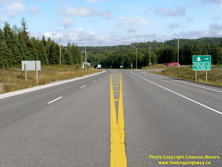
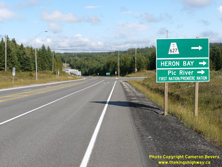
Left - Facing east along Hwy 17 approaching the Hwy 627 Junction near Marathon. See an
Enlarged Photo Here. (Photograph taken on August 29, 2011 - © Cameron Bevers) Right - Green guide sign facing eastbound Hwy 17 traffic marking the Hwy 627 Junction. See an Enlarged Photo Here. (Photograph taken on August 29, 2011 - © Cameron Bevers) 

Left - Facing south along Hwy 627 towards Heron Bay from the Hwy 17 Junction. See an
Enlarged Photo Here. (Photograph taken on August 29, 2011 - © Cameron Bevers) Right - Approaching the northern terminus of Hwy 627 at the Hwy 17 Junction east of Marathon. See an Enlarged Photo Here. (Photograph taken on August 29, 2011 - © Cameron Bevers) 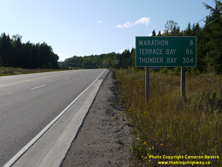

Left - Distance guide sign facing westbound traffic on Hwy 17 at the Hwy 627 Junction. See an
Enlarged Photo Here. (Photograph taken on August 29, 2011 - © Cameron Bevers) Right - Blue-and-white municipality sign approaching Marathon on westbound Hwy 17. Marathon is the largest town located along Lake Superior's North Shore. See an Enlarged Photo Here. (Photograph taken on August 29, 2011 - © Cameron Bevers) 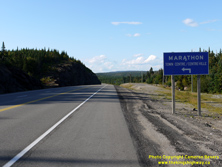

Left - Blue guide sign indicating the upcoming turn-off to Marathon's Town Centre. Nearly all of the town's amenities are located about 4 km south of Hwy 17,
via Peninsula Road (Formerly Hwy 626). Some highway services are located at the Hwy 17 & Hwy 626 Junction. Motorists who are running low on fuel are well-advised
to fill up at Marathon, as there are no services heading westbound along Hwy 17 until Terrace Bay, which lies about 80 km to the west of Marathon. See an
Enlarged Photo Here. (Photograph taken on August 29, 2011 - © Cameron Bevers) Right - Facing east along Hwy 17 towards the Town of White River from the Former Hwy 626 Junction (Peninsula Road) in Marathon. See an Enlarged Photo Here. (Photograph taken on August 29, 2011 - © Cameron Bevers) 
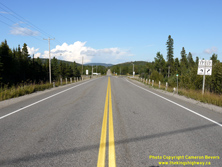
Left - Approaching the Former Hwy 626 Junction (Peninsula Road) on Hwy 17 in Marathon, facing west. The right-turn lane from northbound Peninsula Road to
eastbound Hwy 17 is channelized. The Marathon Entrance Highway was designated as Secondary Highway 626 in 1978. Hwy 626 remained in the provincial highway system
until 1997, when it was transferred or "downloaded" to the Town of Marathon. See an
Enlarged Photo Here. (Photograph taken on August 29, 2011 - © Cameron Bevers) Right - Approaching the Hwy 17 Junction on northbound Hwy 626 (Peninsula Road). At the time this photo was taken, the directional tabs on the junction assembly at right still reflected the old "North" and "South" cardinal directions for Hwy 17, which were apparently in the process of being changed over during my visit in 2011. See an Enlarged Photo Here. (Photograph taken on August 29, 2011 - © Cameron Bevers) 
Above - Secondary Highway 626 route marker at the Hwy 17 Junction in Marathon. See an
Enlarged Photo Here. (Photograph taken on August 30, 2003 - © Cameron Bevers) 
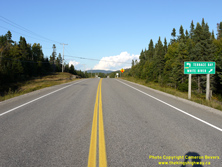
Left - Junction sign assembly at the northern terminus of Hwy 626 at the Hwy 17 Junction. Note that on this signpost, Hwy 17 is signed with the new "East" and
"West" cardinal direction tabs. Although Hwy 17 does follow a predominantly east-west route from Nipigon to the White River area, there are so few intersecting roads
along this stretch of the highway that cardinal directions are rather irrelevant. See an
Enlarged Photo Here. (Photograph taken on August 29, 2011 - © Cameron Bevers) Right - Destination guide sign approaching the northern terminus of Hwy 626 in Marathon. See an Enlarged Photo Here. (Photograph taken on August 29, 2011 - © Cameron Bevers) 

Left - Close-up of the destination guide sign on Hwy 626. Interestingly, a Helvetica font was used for the lettering on this sign. The Ministry of
Transportation of Ontario (MTO) briefly experimented with Helvetica fonts on green-and-white highway signs in the late 1980s and early 1990s, but subsequently
discontinued the font's use. The vast majority of green-and-white highway guide signs in Ontario use the Federal Highways Administration (FHWA) Highway Gothic font
series for lettering. See an Enlarged Photo Here. (Photograph taken on August 29, 2011 - © Cameron Bevers) Right - Approaching the Former Hwy 626 Junction (Peninsula Road) on Hwy 17 in Marathon, facing east. It would appear that after Hwy 626 was transferred to the municipality in the 1990s, that MTO struggled with how best to sign this turn-off. The combination of a blue guide sign and green guide sign on the same signpost is very unusual. Prior to downloading, Hwy 626 would have had its own signboard on top with a right-pointing arrow, along with a "Marathon" destination tab. For a number of years in the 1950s, Hwy 17 ended in Marathon. See an Enlarged Photo Here. (Photograph taken on August 29, 2011 - © Cameron Bevers) 

Left - Facing west along Hwy 17 towards Terrace Bay from the Peninsula Road (Former Hwy 626) Junction in Marathon. The section of Hwy 17 from Schreiber to
Marathon was completed and opened to traffic in September 1953, after a gruelling 16 years of construction through some of the roughest and most remote terrain found
in the province. Construction of Hwy 17 east of Schreiber was already underway by the late 1930s, but progress was interrupted by the outbreak of World War II.
The DHO's construction of the new highway fell silent in 1940, after the highway had been completed to a point about 8 miles east of Schreiber. After a brief hiatus,
work was resumed on the Trans-Canada Highway during the war by the federal government. Portions of the highway between Marathon and Schreiber were cleared and
constructed by interned Japanese-Canadians. In a particularly shameful and paranoia-fuelled decision in 1942, the Government of Canada forced many Japanese-Canadians
from their homes and into internment camps during World War II. Some of these camps were located in the vicinity of Schreiber. Those who were able-bodied were forced
to work on building sections of the Trans-Canada Highway. The DHO resumed construction activities for the easterly extension of Hwy 17 from Schreiber to Marathon
shortly after World War II ended. The DHO's first Post-War construction contracts for Hwy 17 east of Schreiber were awarded in the Spring of 1947. See an
Enlarged Photo Here. (Photograph taken on August 29, 2011 - © Cameron Bevers) Right - Distance guide sign facing westbound traffic on Hwy 17 at the Hwy 626 Junction (Peninsula Road) in Marathon. See an Enlarged Photo Here. (Photograph taken on August 29, 2011 - © Cameron Bevers)
Continue on to King's Highway 17 Photos: Marathon to Terrace Bay
|
|---|
Links to Adjacent King's Highway Photograph Pages:
Back to King's Highway 16 Photos /
King's Highway 17 History /
On to King's Highway 18 Photos
Ontario Highway History - Main Menu / Back to List of Highways Website contents, photos & text © 2002-2025, Cameron
Bevers (Webmaster) - All Rights Reserved / Contact Me |
|---|